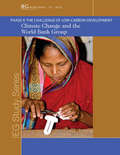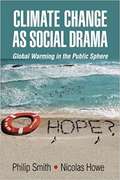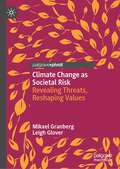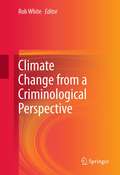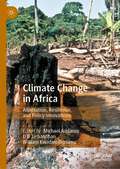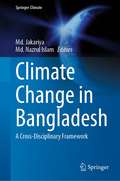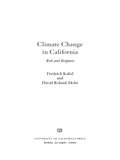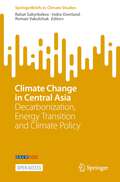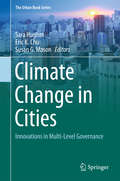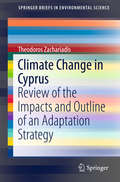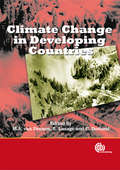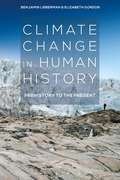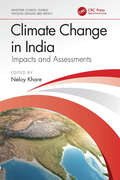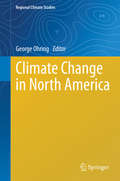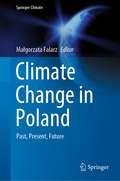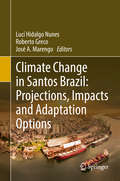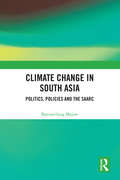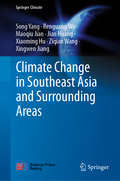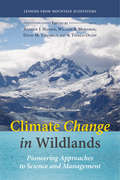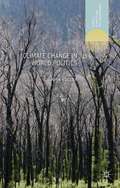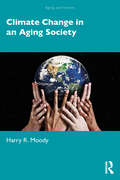- Table View
- List View
Climate Change and the World Bank Group
by The World BankThis study from the Independent Evaluation Group draws lessons for development and climate change mitigation from the World Bank Group's far-reaching portfolio of projects in energy, forestry, transport, coal power, and technology transfer. Reviewing what has worked, what hasn't, and why, the evaluation's key findings include: Energy efficiency can offer countries direct economic returns that dwarf those of most other development projects, while also reducing greenhouse gas emissions. Tropical forest protected areas, on average, significantly reduce tropical deforestation, preserving carbon and biodiversity. Deforestation rates are lower in areas that allowed sustainable use by local populations than in strictly protected areas. Deforestation rates were lowest of all in indigenous forest areas. For renewable energy projects, long-duration loans have been important in making projects financially viable.. But at prevailing carbon prices, carbon offset sales had little impact on most renewable energy projects' rate of returns, and did not address investors' need for up-front capital. Technology transfer - broadly understood to include diffusion of technical and financial innovations related to low-carbon development - has worked well when the logic of piloting and demonstration is well thought out, and when grants are used to mitigate the risk of pioneering efforts.
Climate Change as Social Drama
by Philip Smith Nicolas Howe Smith, Philip and Howe, NicolasClimate change is not just a scientific fact, nor merely a social and political problem. It is also a set of stories and characters that amount to a social drama. This drama, as much as hard scientific or political realities, shapes perception of the problem. Drs Smith and Howe use the perspective of cultural sociology and Aristotle's timeless theories about narrative and rhetoric to explore this meaningful and visible surface of climate change in the public sphere. Whereas most research wants to explain barriers to awareness, here we switch the agenda to look at the moments when global warming actually gets attention. Chapters consider struggles over apocalyptic scenarios, explain the success of Al Gore and An Inconvenient Truth, unpack the deeper social meanings of the climate conference and 'Climategate', critique failed advertising campaigns and climate art, and question the much touted transformative potential of natural disasters such as Superstorm Sandy.
Climate Change as Societal Risk: Revealing Threats, Reshaping Values
by Mikael Granberg Leigh GloverThis book analyzes climate change from a societal risk perspective, considering IPCC data, harm reduction, and global impact. Climate change is a globalised agent of social disruption whose impacts will worsen societal inequities and inequalities around the world. For some unfortunate societies already precariously exposed, climate change will tip them into societal collapse. Devastation will also occur to many ecological values in which all societies are embedded. But effective social action can limit the extent of these costs and losses. Ultimately, only social transformation can limit the social and environmental harms of climate change. But what does this mean? To what extent is society at risk? Are such risks particularized and restricted to specific segments and localities? Or is society at risk in a more universal way? Climate risks are re-shaping the practices of households, communities, governments and businesses. In this way, climate risks are a dynamic element in social change and social processes. Risk holds a mirror to society, revealing who and what is prioritized, recognized and valued. It also provides a reckoning of our perceived strengths, vulnerabilities and weaknesses. This volume examines how we understand the societal risks of contemporary and forecast climate change impacts—and those risks inherent in dealing with these impacts. We know that society is fashioning a new global climate—but climate change is also re-fashioning society; this book explores this dynamic process and considers its implications for future society.
Climate Change from a Criminological Perspective
by Rob WhiteFew would dispute the power of climate change to lead to profoundly destructive weather events. At the same time, the possibility of climate change as a consequence--or even a cause--of criminal events is far less recognized. As the earth grows warmer, issues regarding land use, water rights, bio-security, and food production and distribution will continue to have far-reaching impact, and produce more opportunity for offenses by individuals and groups as well as political and corporate entities. In Climate Change from a Criminological Perspective, a panel of pioneering green criminologists investigates an increasingly complex chain of ecological causes and effects. Illegal acts are analyzed as they contribute to environmental decline (e.g., wildlife poaching) or result from ecological distress (e.g., survival-related theft). Regulatory and other interventions are critiqued, concepts of environmental harm refined, and new research methodologies called for. And while individual events described are mainly local, the contributors keep the global picture, and substantial questions about human rights and social relationships, firmly in mind. Topics featured include: Global warming as corporate crime. Climate change and the courts: U.S. and global views. Climate change, natural disasters, and gender inequality. The roles and responsibilities of environmental enforcement networks. A sociocultural perspective on climate change denial. PLUS: instructive in-depth chapters on criminological aspects of Hurricane Katrina and the Japanese nuclear disaster. A volume of considerable timeliness and vision, Climate Change from a Criminological Perspective will be read and discussed, and will inspire action, by researchers in criminology, criminal justice, environmental studies, and related disciplines, as well as policymakers.
Climate Change from the Streets: How Conflict and Collaboration Strengthen the Environmental Justice Movement
by Michael MendezAn urgent and timely story of the contentious politics of incorporating environmental justice into global climate change policy Although the science of climate change is clear, policy decisions about how to respond to its effects remain contentious. Even when such decisions claim to be guided by objective knowledge, they are made and implemented through political institutions and relationships—and all the competing interests and power struggles that this implies. Michael Méndez tells a timely story of people, place, and power in the context of climate change and inequality. He explores the perspectives and influence low‑income people of color bring to their advocacy work on climate change. In California, activist groups have galvanized behind issues such as air pollution, poverty alleviation, and green jobs to advance equitable climate solutions at the local, state, and global levels. Arguing that environmental protection and improving public health are inextricably linked, Mendez contends that we must incorporate local knowledge, culture, and history into policymaking to fully address the global complexities of climate change and the real threats facing our local communities.
Climate Change in 2017: Implications for Business
by Rebecca Henderson Amram Migdal Sophus A Reinert Polina DekhtyarProfessors Rebecca M. Henderson and Sophus A. Reinert, Polina Dekhtyar (MBA 2016), and Case Researcher Amram Migdal (Case Research & Writing Group) prepared this note as the basis for class discussion.
Climate Change in Africa: Adaptation, Resilience, and Policy Innovations
by Michael Addaney D B Jarbandhan William Kwadwo DumenuThis edited collection chronicles the public policy responses to climate change and current and potential impacts that will affect critical and priority sectors within and across African countries now and in the coming decades. Contributions cover governance and policy responses to climate change, emphasizing continental governance and policy responses, national governance and policy responses (what selected countries in Africa are doing), and local or community policy and programmatic responses (what some selected major African communities are doing). Each chapter adopts multi-disciplinary and transdisciplinary approaches, combining insights from social and policy sciences, emphasizing existing gaps, particularly in the area of decision-making, governance and local climate action. The book offers both theoretical and practical contributions, with the aim of advancing academic discourse and thinking, policymaking and implementation of climate interventions in Africa.
Climate Change in Bangladesh: A Cross-Disciplinary Framework (Springer Climate)
by Md. Nazrul Islam Md. JakariyaThis book is a comprehensive resource for climate change impacts and scenarios on cross-cutting issues in Bangladesh and other tropical low-lying countries in Asia. The book promotes mitigation and adaptation strategies for learning and innovation to tackle climate change impacts, reduce inequality, as well as include changes in food, energy, health, education, and social protection policies in Bangladesh and Asian low-lying countries.Through several case studies, this book provides a powerful framework for identifying management tools and their applications in environment and governance including; climate change and natural hazards, climate change and energy framework, gender inequality and capacity building, and community participants and the actions needed to protect them.The aim of this book is to provide information to scientists, practitioners, academics, and government and non-government policy-makers to help them better understand the particularities of climate change adaptation and mitigation strategies for cross-cutting issues in Bangladesh.
Climate Change in California
by Fredrich J. Kahrl David W. Roland-HolstCalifornia is synonymous with opportunity, prosperity, and natural beauty, but climate change will certainly influence the state's future. Changes will affect the economy, natural resources, public health, agriculture, and the livelihoods of its residents. But how big is the risk? How will Californians adapt? What will it cost? This book is the first to ask and attempt to answer these and other questions so central to the long-term health of the state. While California is undeniably unique and diverse, the challenges it faces will be mirrored everywhere. This succinct and authoritative review of the latest evidence suggests feasible changes that can sustain prosperity, mitigate adverse impacts of climate change, and stimulate research and policy dialog across the globe. The authors argue that the sooner society recognizes the reality of climate change risk, the more effectively we can begin adaptation to limit costs to present and future generations. They show that climate risk presents a new opportunity for innovation, supporting aspirations for prosperity in a lower carbon, climate altered future where we can continue economic progress without endangering the environment and ourselves.
Climate Change in Central Asia: Decarbonization, Energy Transition and Climate Policy (SpringerBriefs in Climate Studies)
by Indra Overland Rahat Sabyrbekov Roman VakulchukThis open access book explores climate change impacts, adaptation, and mitigation in Central Asia and discusses policy options for the Central Asian governments. To address the urgent need for local scholarship on climate change in Central Asia, and in particular the need for more research by social scientists, this book features a wide range of contributions on climate change impacts, adaptation and mitigation in the region. Each chapter makes an important contribution to social science scholarship on climate change and decarbonization in Central Asia. Topics include decarbonization opportunities, carbon pricing instruments, the geo-economics of the energy transition, the relationship between human mobility and climate change. The book thus offers valuable insights for both academics and policymakers.
Climate Change in Cities: Innovations in Multi-Level Governance (The Urban Book Series)
by Sara Hughes Eric K. Chu Susan G. MasonThis book presents pioneering work on a range of innovative practices, experiments, and ideas that are becoming an integral part of urban climate change governance in the 21st century. Theoretically, the book builds on nearly two decades of scholarships identifying the emergence of new urban actors, spaces and political dynamics in response to climate change priorities. However, it further articulates and applies the concepts associated with urban climate change governance by bridging formerly disparate disciplines and approaches. Empirically, the chapters investigate new multi-level urban governance arrangements from around the world, and leverage the insights they provide for both theory and practice. Cities - both as political and material entities - are increasingly playing a critical role in shaping the trajectory and impacts of climate change action. However, their policy, planning, and governance responses to climate change are fraught with tension a nd contradictions. While on one hand local actors play a central role in designing institutions, infrastructures, and behaviors that drive decarbonization and adaptation to changing climatic conditions, their options and incentives are inextricably enmeshed within broader political and economic processes. Resolving these tensions and contradictions is likely to require innovative and multi-level approaches to governing climate change in the city: new interactions, new political actors, new ways of coordinating and mobilizing resources, and new frameworks and technical capacities for decision making. We focus explicitly on those innovations that produce new relationships between levels of government, between government and citizens, and among governments, the private sector, and transnational and civil society actors. A more comprehensive understanding is needed of the innovative approaches being used to navigate the complex networks and relationships that constitute contemporary multi-level urban climate change governance. Debra Roberts, Co-Chair, Working Group II, IPCC 6th Assessment Report (AR6) and Acting Head, Sustainable and Resilient City Initiatives, Durban, South Africa "Climate Change in Cities offers a refreshingly frank view of how complex cities and city processes really are. " Christopher Gore, Associate Professor and Chair, Department of Politics and Public Administration, Ryerson University, Canada "This book is a rare and welcome contribution engaging critically with questions about cities as central actors in multilevel climate governance but it does so recognizing that there are lessons from cities in both the Global North and South. " Harriet Bulkeley, Professor of Geography, Durham University, United Kingdom "This timely collection provides new insights into how cities can put their rhetoric into action on the ground and explores just how this promise can be realised in cities across the world - from California to Canada, India to Indonesia. "
Climate Change in Cyprus: Review of the Impacts and Outline of an Adaptation Strategy (SpringerBriefs in Environmental Science)
by Theodoros ZachariadisThis book providesa concise overview of facts and projections aboutclimate change in Cyprus and its region until the end of the 21st century. Climate change is expected to have adverse effects in Mediterranean Europe - the most serious compared to other European regions. Being an island state with a semi-arid climate in the Eastern Mediterranean, Cyprus is located in a hot spot. Basedon the information available in the literature, it highlights the expected natural, economic and societal impacts ofclimate change and presents recommendations forthe implementation of a nationaladaptation strategy. Despite the dismal outlook arising from this review,the book demonstrates that coping with climate change is possible, provided thatproactive actions are taken by both the public and the private sector. Publicauthorities need to set clear priorities and set up adequate monitoringmechanisms that can help avoid large natural and economic damages at a laterstage. Enabling private adaptation investments and properly pricing the use ofnatural resources are key priorities for investing in a climate resilienteconomy.
Climate Change in Deserts
by Martin WilliamsThis book reconstructs climatic changes in deserts and their margins at a variety of scales in space and time. It draws upon evidence from land and sea, including desert dunes, wind-blown dust, river and lake sediments, glacial moraines, plant and animal fossils, isotope geochemistry, speleothems, soils, and prehistoric archaeology. The book summarises the Cenozoic evolution of the major deserts of the Americas, Eurasia, Africa and Australia and the causes of historic floods and droughts. The book then considers the causes and consequences of desertification and proposes four key conditions for achieving ecologically sustainable use of natural resources in arid and semi-arid areas. Climate Change in Deserts is an invaluable reference for researchers and advanced students interested in the climate and geomorphology of deserts: geographers, geologists, ecologists, archaeologists, soil scientists, hydrologists, climatologists and natural resource managers.
Climate Change in Developing Countries: Results from the Netherlands Climate Change Studies Assistance Programme
by R. Lasage C. Dorlands M. A. van DrunenThis book presents an overview of the studies conducted by the Netherlands Climate Change Studies Assistance program. The program was set up in recognition of the need for developing countries, in particular, to face the challenges confronting all countries under the UN Framework Convention on Climate Change. The book presents an overview of the main results in 13 countries: Bolivia, Colombia, Ecuador, Egypt, Ghana, Kazakhstan, Mali, Mongolia, Senegal, Suriname, Vietnam, Yemen and Zimbabwe. It provides a critical evaluation of the methodologies and approaches used, a cross-country synthesis and recommendations for further studies. Subjects dealt with include not only impact studies, but also vulnerability and adaptation, mitigation and climate related policy.
Climate Change in Human History: Prehistory to the Present
by Elizabeth Gordon Benjamin LiebermanClimate Change and Human History provides an up-to-date and concise introduction to the relationship between human beings and climate change throughout history. <P><P>Starting with periods hundreds of thousands of years ago and continuing up to the present day, the book illustrates how natural climate variability affected early human societies, and how humans are now altering climate drastically within much shorter periods of time. For each major period of time, the book will explain how climate change has created opportunities as well as risks and challenges for human societies. <P><P>The book introduces and develops several related themes including: <ul> <li>Phases of climate and history</li> <li>Factors that shape climate</li> <li>Climate shocks and sharp climate shifts</li> <li>Climate and the rise and fall of civilizations</li> <li>Industrialization and climate science</li> <li>Accelerating climate change, human societies, and the future</li> </ul> <P><P>An ideal companion for all students of environmental history, Climate Change and Human History clearly demonstrates the critical role of climate in shaping human history and of the experience of humans in both adapting to and shaping climate change.
Climate Change in India: Impacts and Assessments (Maritime Climate Change)
by Neloy KhareThe climate over the Indian subcontinent is influenced by complex interactions between the atmosphere, ocean, and land, along with human interventions that are influencing heat extremes, changing monsoon patterns, sea-level rise, and posing serious threats to lives and livelihoods among populations in India. This book, based on recent studies and research, explains how and why the climate is changing across India and how these changes are expected to evolve in the future. It takes a holistic view of the climate from India’s perspective and discusses important themes such as groundwater, land use, livestock, and natural disasters. Readers will have an in-depth understanding of impacts and possible adaptations.Features Includes case studies of groundwater and the effect of climate change. Identifies land use and land cover changes in different regions in India. Discusses the implications of past and present climate change on various livestock types. Explains various natural hazards and their relationship to climate change. Describes technological intervention in climate change. Researchers, academics, and graduate students in Earth sciences, climatology, meteorology, or environmental studies working on projects related to climate change will find this an invaluable reference. Governmental organizations, institutions, and global NGOs will also benefit from the insights presented in this book.
Climate Change in North America (Regional Climate Studies)
by George OhringThis book describes thoroughly the North American Climate of the past 65 million years, with special emphasis on the last 21,000 years, as revealed by paleoclimatic observations and climate models. It analyzes weather observations over the past century and satellite measurements of the last few decades to develop a picture of more recent climatic trends. It explains how global climate models are used to simulate and project climate, and presents the application of these models to reproduce recent climate variations and predict future North American climate. It answers the critical question of whether observed climate change is due to natural variations or human activity.
Climate Change in Poland: Past, Present, Future (Springer Climate)
by Małgorzata FalarzThis edited book provides a comprehensive overview of the past, present and future climate development in Poland. The book consists of three main parts. The first part presents the results of the study of climate change before instrumental measurements in Poland in the last millennium. The second part analyses the long-term changes and variability of 36 climate characteristics for 14 climate elements, indices, meteorological phenomena and weather types using data from 79 weather stations in the base period 1951–2018 and for long series up to 239 years (1780–2018). The particular attention is paid to climate extremes. The third part of the book deals with projected changes in temperature, precipitation and thermal indices related to the agriculture and energy sectors. Two future time horizons are carried out: 1) near future: 2021–2050 and 2) far future: 2071–2100. The results for Poland are compared to those from Europe and other parts of the world.The book is addressed to scientists (climatologists, geographers, etc.), academic teachers, students, journalists and all those interested in Poland and climate change in Poland.
Climate Change in Santos Brazil: Projections, Impacts and Adaptation Options
by Lucí Hidalgo Nunes Roberto Greco José A. MarengoThis book is the result of the project METROPOLE: An Integrated Framework to Analyse Local Decision Making and Adaptive Capacity to Large-Scale Environmental Change: Community Case Studies in Brazil, UK and the US, supported by the Belmont Forum-G8 Initiative Collaborative Research (Coastal Vulnerability, G8MUREFU3 2201-040). The Project METROPOLE was designed to address some important challenges of our time: on one hand, how to reduce the risks from climate change in coastal areas, in view of safeguarding life, assuring the safety of assets and the maintenance of rich ecosystems; and on the other hand, how to improve the interaction between scientists, decision makers and population for a common goal, to prevent alarming projections of sea level rise from being realized. This book focuses on the basis of the project which is anchored in the recognition of the importance of both dialogue and action on climate change involving different actors. Therefore, the participation of decision-makers, the population and representatives of civil and private organizations are key-elements in ensuring measures that might slow down, minimise or even restrict the perverse effects of climate change.
Climate Change in South Asia: Politics, Policies and the SAARC
by Baniateilang MajawThis volume studies the challenges of climate change in South Asia and examines the role of the South Asian Association for Regional Cooperation (SAARC) in addressing them. It highlights the dangers posed by climate change in South Asia and underlines the need to strengthen and intensify regional cooperation to preserve, protect and manage the diverse and fragile eco-systems of the region. The book examines policies and initiatives of the SAARC in tackling these issues and also analyzes their implementation by member countries. Comprehensive and topical, this volume will be useful for scholars and researchers of South Asian Studies, environmental studies, climate change studies, public policy and governance, development studies, international relations, regional cooperation, and political studies. It will also be of importance to policymakers and NGOs working in this field.
Climate Change in Southeast Asia and Surrounding Areas (Springer Climate)
by Xiaoming Hu Jian Huang Song Yang Renguang Wu Maoqiu Jian Ziqian Wang Xingwen JiangThis book is mainly focused on the climate change in Southeast Asia and its adjacent regions. It summarizes results from recent scientific research based on observational analysis, data diagnosis, theoretical analysis, and model simulations. The book covers the following research areas: (1) characteristics and mechanisms of spring–summer atmospheric circulation systems, (2) ocean-atmosphere-land interaction and climate variability, (3) climate effect of the Tibetan Plateau, (4) attribution of regional climate change and feedback/impact of regional climate on the global climate, and (5) seasonal-to-subseasonal climate prediction. It is anticipated that the book provides useful information for enhancing our understanding of the change in climate over Southeast Asia and the adjacent regions.
Climate Change in Sustainable Water Resources Management (Springer Water)
by Omid Bozorg-HaddadThis book provides a comprehensive approach to all aspects of water-related subjects affected by climate change that expand readers' attitudes toward future of the management strategies and improve management plans. It summarizes climate change scenarios, models, downscaling methods, and how to select the appropriate method. It also introduces practical steps in assessing climate change impacts on water issues through introducing hydrological models and climate change data applications in hydrologic analysis. The book caters to specialist readers who are interested in analyzing climate change effects on water resources, and related issues can gain a profound understanding of the practical concepts and step-by-step analysis, which is enriched with real case studies all around the world. Moreover, readers will be familiar with potential mitigation and adaptation measures in sustainable water engineering, considering the results of hydrologic modeling.
Climate Change in Wildlands: Pioneering Approaches to Science and Management
by Andrew J. Hansen William B. Monahan S. Thomas Olliff David M. TheobaldScientists have been warning for years that human activity is heating up the planet and climate change is under way. In the past century, global temperatures have risen an average of 1. 3 degrees Fahrenheit, a trend that is expected to only accelerate. But public sentiment has taken a long time to catch up, and we are only just beginning to acknowledge the serious effects this will have on all life on Earth. The federal government is crafting broad-scale strategies to protect wildland ecosystems from the worst effects of climate change. The challenge now is to get the latest science into the hands of resource managers entrusted with protecting water, plants, fish and wildlife, tribal lands, and cultural heritage sites in wildlands. Teaming with NASA and the Department of the Interior, ecologist Andrew Hansen, along with his team of scientists and managers, set out to understand how climate and land use changes affect montane landscapes of the Rockies and the Appalachians, and how these findings can be applied to wildlands elsewhere. They examine changes over the past century as well as expected future change, assess the vulnerability of species and ecosystems to these changes, and provide new, collaborative management approaches to mitigate expected impacts. A series of case studies showcases how managers might tackle such wide-ranging problems as the effects of warming streams on cold-water fish in Great Smoky Mountain National Park and dying white-bark pine stands in the Greater Yellowstone area. A surprising finding is that species and ecosystems vary dramatically in vulnerability to climate change. While many will suffer severe effects, others may actually benefit from projected changes. Climate Change in Wildlands is a collaboration between scientists and managers, providing a science-derived framework and common-sense approaches for keeping parks and protected areas healthy on a rapidly changing planet.
Climate Change in World Politics (Energy, Climate and the Environment)
by John VoglerJohn Vogler examines the international politics of climate change, with a focus on the United Nations Framework Convention (UNFCCC). He considers how the international system treats the problem of climate change, analysing the ways in which this has been defined by the international community and the interests and alignments of state governments.
Climate Change in an Aging Society (Aging and Society)
by Harry R. MoodyClimate Change in an Aging Society is the first book fully devoted to the impact of climate change on those who are old today—and those who will be old in decades to come. In doing so, Moody focuses on issues of critical importance: aging in place; health and age in a warming world; responsibility for the climate crisis; options for climate-conscious consumers; planning for investment for a green retirement; and opportunities for political action.The number of Americans aged over 65 is projected to rise from 17% to 21%. By 2060 nearly one in four Americans will be 65 or older. By 2050, however, average temperatures in the USA could rise by as much as 3°C, and extreme weather events are likely to become more frequent and severe. Despite these alarming projections and the likelihood that climate change will cause serious health issues among the elderly, little attention has been devoted to the impact of climate change on this demographic. Employing a life-course perspective and a cross-generational approach, Moody assesses the impact of climate change on those who are old today and those who will be old in years to come. Challenging both climate complacency and climate defeatism, the book adopts as its clarion call, HERE NOW YOU HOPE.Written in an engaging personal style with highlighting case studies of influential "eco-elders," this urgent book will be of great interest to students and scholars with interests in climate change, gerontology, and environmental and social policy.
